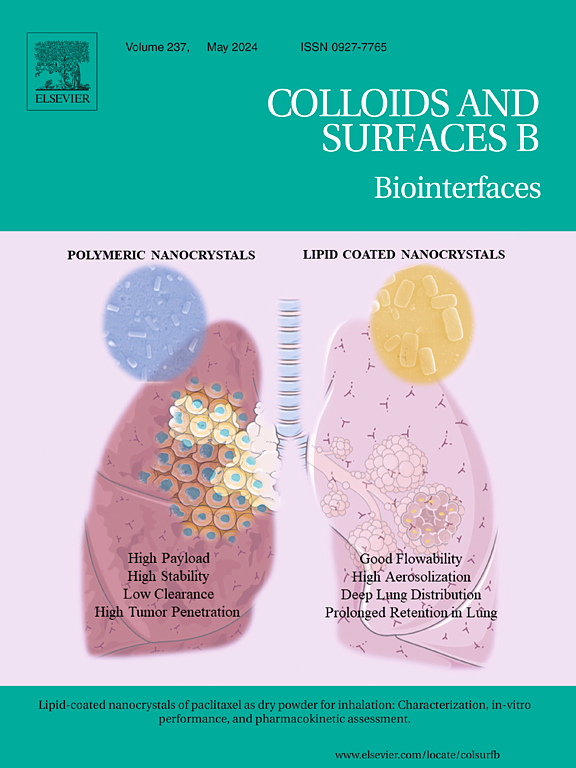含GHK-Cu三肽的羟基磷灰石微球抗炎抗氧化填充剂
IF 5.6
2区 医学
Q1 BIOPHYSICS
引用次数: 0
摘要
随着软组织填充物的广泛应用,种植体材料引起的炎症反应已成为影响治疗效果的关键因素。本研究通过将甘酰基-l -组氨酸-l -赖氨酸铜络合物(GHK-Cu)吸附到羟基磷灰石微球(HAPs)上,开发了一种具有增强抗炎和抗氧化作用的注射填充物,标志着HAPs和GHK-Cu首次联合用于解决软组织填充物引起的炎症。通过静电吸附成功地将GHK-Cu吸附到HAPs上。然后将HAPs与羧甲基纤维素(CMC)、甘油(GLY)和水混合形成GHK-Cu@CMHA凝胶。研究的重点是HAPs作为持续递送GHK-Cu的载体的有效联合以及GHK-Cu的抗炎特性。GHK-Cu@CMHA具有7天的缓释特性,确保延长治疗效果,最大限度地减少肽浪费,减少注射频率,具有良好的流动性和注射性。在lps诱导的体内和体外炎症模型中,GHK-Cu@CMHA凝胶降低了炎症因子水平,活性氧(ROS)水平下降,超氧化物歧化酶(SOD)活性增强。在此过程中,H&;E染色和Masson染色显示明显的胶原沉积。这些发现进一步证实GHK-Cu@CMHA是一种新型的可注射软组织填充剂,具有良好的抗炎和抗氧化性能,具有良好的炎症抑制潜力。本文章由计算机程序翻译,如有差异,请以英文原文为准。
An injectable hydroxyapatite microsphere filler loaded with GHK-Cu tripeptide for anti-Inflammatory and antioxidant
With the wide application of soft tissue fillers, implant material-induced inflammatory reactions have become a key factor affecting the therapeutic efficacy. This study developed an injectable filler with enhanced anti-inflammatory and antioxidant effects by adsorbing glycyl-L-histidyl-L-lysine copper complex (GHK-Cu) onto hydroxyapatite microspheres (HAPs), marking the first combination of HAPs and GHK-Cu to address inflammation caused by soft tissue fillers. GHK-Cu was successfully loaded onto HAPs by electrostatic adsorption. HAPs were then mixed with carboxymethyl cellulose (CMC), glycerol (GLY), and water to form GHK-Cu@CMHA gel. The study focus on the effective combination of HAPs as a carrier for sustained GHK-Cu delivery and the anti-inflammatory properties of GHK-Cu. GHK-Cu@CMHA exhibits sustained release properties for 7 days, which ensures prolonged therapeutic effects, minimizes peptide waste and reduces injection frequency, with good flowability and injectability. In the model of LPS-induced inflammation model in vivo and in vitro, GHK-Cu@CMHA gel reduced levels of inflammatory factors and Reactive oxygen species (ROS) levels decreased, while superoxide dismutase (SOD) activity was enhanced. In this process, H&E staining and Masson staining revealed significant collagen deposition. These findings further confirm that GHK-Cu@CMHA is a novel injectable soft tissue filler with good anti-inflammatory and antioxidant properties, which holds well potential for inflammation inhibition.
求助全文
通过发布文献求助,成功后即可免费获取论文全文。
去求助
来源期刊

Colloids and Surfaces B: Biointerfaces
生物-材料科学:生物材料
CiteScore
11.10
自引率
3.40%
发文量
730
审稿时长
42 days
期刊介绍:
Colloids and Surfaces B: Biointerfaces is an international journal devoted to fundamental and applied research on colloid and interfacial phenomena in relation to systems of biological origin, having particular relevance to the medical, pharmaceutical, biotechnological, food and cosmetic fields.
Submissions that: (1) deal solely with biological phenomena and do not describe the physico-chemical or colloid-chemical background and/or mechanism of the phenomena, and (2) deal solely with colloid/interfacial phenomena and do not have appropriate biological content or relevance, are outside the scope of the journal and will not be considered for publication.
The journal publishes regular research papers, reviews, short communications and invited perspective articles, called BioInterface Perspectives. The BioInterface Perspective provide researchers the opportunity to review their own work, as well as provide insight into the work of others that inspired and influenced the author. Regular articles should have a maximum total length of 6,000 words. In addition, a (combined) maximum of 8 normal-sized figures and/or tables is allowed (so for instance 3 tables and 5 figures). For multiple-panel figures each set of two panels equates to one figure. Short communications should not exceed half of the above. It is required to give on the article cover page a short statistical summary of the article listing the total number of words and tables/figures.
 求助内容:
求助内容: 应助结果提醒方式:
应助结果提醒方式:


